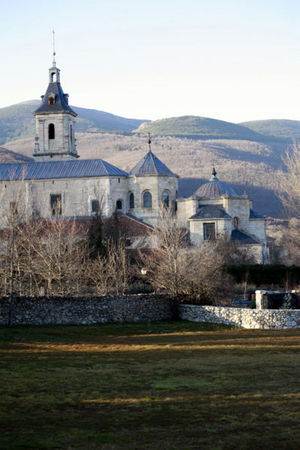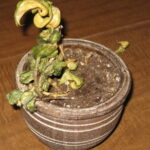“Spreading herbs and flowerets bright,
Glisten’d with the dew of night,
Nor herb nor floweret glisten’d there,
But was carved in the cloister-arches as fair.”
-Sir Walter Scott, The Lay of the Last Minstrel, Canto II
Monastic communities were designed to be largely self sufficient. The monks needed to grow all the plant material they required for their daily survival such as foods, seasonings, medications, dye plants, aromatics, pest and insect control.
St. Benedict was the founder of the Benedictine monastic order. St. Benedict drew up his monastic rule in the 6th century for use by his monastic community in Monte Cassino, Italy. The following passage is from the 66th chapter of the Regula Sancti Benedicti (Rule of Saint Benedict):
“Whenever possible the monastery should be laid out so that everything essential, that is to say water, mills, garden and workshops for the plying of the various crafts, is found within the monastery walls.”
The location of monasteries was usually keyed to discovering a source of water such as a natural spring, pond or river. The water source could be diverted to various locations throughout the monastery to be used for cooking, bathing and watering the gardens. Discovering a reliable source of water was an essential element necessary for the self sufficiency of the monasteries.
Types of Monastic Gardens
“And the LORD God planted a garden eastward in Eden; and there he put the man whom he had formed. And out of the ground made the LORD God to grow every tree that is pleasant to the sight, and good for food; the tree of life also in the midst of the garden, and the tree of knowledge of good and evil. And a river went out of Eden, to water the garden; and from thence it was parted, and became into four heads.”
–Genesis 2:8-10
Cloister garth
The cloister garth was a centrally located courtyard surrounded by the main buildings of the monastery namely the church, refectory, and dormitory. It contained covered alleys or hallways with a central portion open to the sky and enabled the monks to walk and meditate while partaking of the fresh air. The central courtyard section was sometimes planted with herbs and flowers. This garden was often divided into quadrants thought to represent either the four rivers of the garden of Eden or the four elements, namely earth, air, fire and water. The cloister garth often included a central fountain or sundial as part of its design.
Cemetery/orchard
When monks passed away at the monastery they were buried in the monasteries cemetery. The cemetery and surrounding grounds would often be planted with various fruit and nut trees such as apples, pears, cherries, walnuts and almonds. The fruits harvested from the trees, besides being used for culinary purposes, were also used to make a variety of beverages such as cider and perry. Perry was a fermented beverage similar to cider but made with pears instead of apples.
Kitchen
The kitchen garden was known in Latin as the hortus. Culinary herbs were grown in the kitchen garden along with many varieties of vegetables. This garden was located close to the kitchen in order to facilitate the preparation of meals. The poultry and other animal pens would have been located close to the kitchen garden as the manure cleaned out of the pens would have provided a ready source of organic fertilizer that could be used on the garden planting beds.
In addition to the various types of vegetables grown in the kitchen garden a variety of culinary herbs such as dill, oregano and parsley would also be grown in this garden.
Physic
This garden was known in Latin as the herbularius and is the most interesting of all the monastery gardens for anyone interested in herbs. Medicinal herbs were grown in the physic garden. This garden was located close to the infirmary so that the herbs would be ready to harvest at a moments notice. The herbs were often grown in raised beds with pathways between the beds. Only one type of herb was grown per bed.
The herbs grown in the physic garden were in great demand throughout the monastery. They were utilized for their healing properties to aid any monks that had taken ill and to help heal the sick and poor people that took shelter in the monasteries. The monastery infirmary frequently doubled as the local hospital in areas that didn’t have separate hospitals for travelers and local peasants who couldn’t afford to hire a physician.
The infirmary garden would have also offered a place for convalescents to stroll about in the fresh air while they were recuperating from their illness. A turf seat was an extra feature that may have been planted in some physic gardens. This was a raised bench-like bed which was planted with aromatic herbs such as chamomile or thyme. The herbs delightful fragrance would be released whenever someone sat upon the seat allowing the seat to act as a sort of ancient aromatherapy.
Sacristan
The Sacristan garden was for the growing of various flowers which were used to decorate statues of the saints and of the Virgin Mary which were located throughout the monastery. The flowers would also be used to decorate the altar of the church chapel and used to make garlands and wreaths which were used during the various feast days of the saints.
The flowers grown here could also be used to decorate the guest rooms and refectory. The refectory was the communal dinning hall where the monks took their meals together. The sacristan garden was sometimes called Paradise as an illusion to the garden of Eden. White roses and lilies were among the more popular flowers grown in the sacristan garden as the color white symbolized purity.
Abbot’s Garden
Although the monks were forbidden to own any personal property once they joined the monastery many abbots had their own personal garden for the growing of their favorite plant varieties. The abbots garden was usually off-limits to the rest of the monastery inhabitants but the abbot may have allowed high ranking visitors to the monastery access to his personal garden. The abbot may have grown his favorite varieties of herbs, roses, and other flowers in this garden.
Farmland/Forests
The monasteries usually had farm land located outside of the monastery for the growing of crops such as grains and grape vines. These crops needed more space than was contained in the gardens located within the confines of the walled monastery. Although some fruit trees may have been grown in the monastery cemetery any large orchards were planted outside of the monastery in the surrounding farm land.
Herbs would also have been wild crafted from the surrounding countryside whenever possible. Those plants which couldn’t be found in the surrounding fields and forests or in sufficient quantity would be cultivated by the monks in the physic and kitchen gardens. Visiting monks from other monasteries would often bring presents of herb plants and seeds along with them enabling a monastery to obtain a collection of herbs and plants not commonly available in their area.
Resources
Bayard, Tania. Sweet Herbs and Sundry Flowers; Medieval Gardens and the Gardens of the Cloisters. New York: The Metropolitan Museum of Art, David R. Godine Publisher, 1985.
MacDougall, Elisabeth B. (ed.). Dumbarton Oaks Colloquium on the History of Landscape Architecture IX. Dumbarton Oaks Research Library and Collection, 1986. “The Medieval Monastic Garden.” Paul Meyvaret, pages 23-54.
Peplow, Elizabeth & Reginald Peplow. In a Monastery Garden. David & Charles, 1988.
Reference:
- Bonnefont Cloister Herb Garden: www.fordham.edu/halsall/medny/herbgdn1.html




